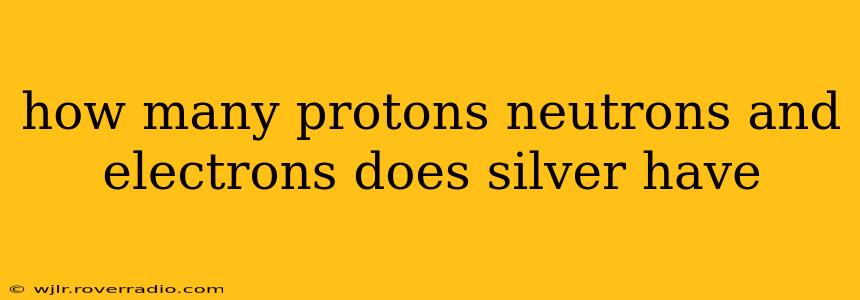Silver (Ag), a lustrous, white metallic element, holds a significant place in various industries, from jewelry to electronics. Understanding its atomic structure—specifically, the number of protons, neutrons, and electrons—is key to appreciating its chemical and physical properties. Let's delve into the details.
How Many Protons Does Silver Have?
The number of protons defines an element. Silver's atomic number is 47, meaning every silver atom has 47 protons. This is a fundamental characteristic that doesn't change.
How Many Electrons Does Silver Have?
In a neutral atom, the number of electrons equals the number of protons. Therefore, a neutral silver atom also has 47 electrons. However, it's crucial to remember that silver can lose or gain electrons, forming ions with differing numbers of electrons. This is common in chemical reactions.
How Many Neutrons Does Silver Have?
This is where things get a little more complex. Unlike protons and electrons (which are fixed for a given element in its neutral state), the number of neutrons can vary. These variations are called isotopes. The most common isotope of silver is Silver-107 (¹⁰⁷Ag), which has 60 neutrons (107 - 47 = 60). Another significant isotope is Silver-109 (¹⁰⁹Ag), containing 62 neutrons (109 - 47 = 62). The relative abundance of these isotopes in nature contributes to the average atomic mass of silver, which is approximately 107.87 atomic mass units (amu).
What are the different isotopes of Silver?
Silver has two main stable isotopes:
- Silver-107 (¹⁰⁷Ag): This isotope makes up about 51.8% of naturally occurring silver. As previously mentioned, it has 47 protons and 60 neutrons.
- Silver-109 (¹⁰⁹Ag): This isotope constitutes approximately 48.2% of naturally occurring silver and possesses 47 protons and 62 neutrons.
There are also several radioactive isotopes of silver, but these are not naturally occurring and are produced synthetically.
What is the atomic mass of Silver?
The atomic mass of silver, often listed as 107.87 amu, is a weighted average reflecting the relative abundances of its stable isotopes, ¹⁰⁷Ag and ¹⁰⁹Ag. This average mass is used in chemical calculations.
What is the electron configuration of Silver?
The electron configuration of silver is [Kr]4d¹⁰5s¹. This arrangement of electrons in its various shells explains many of silver's chemical and physical properties.
In summary, while the number of protons (47) and electrons (47 in a neutral atom) are fixed for silver, the number of neutrons can vary depending on the isotope. Understanding these fundamental aspects is essential for comprehending silver's behavior in various chemical and physical contexts.
